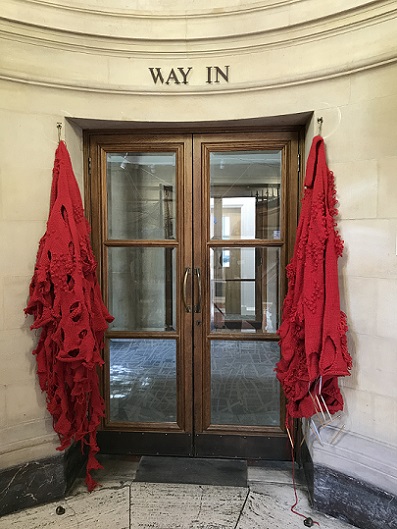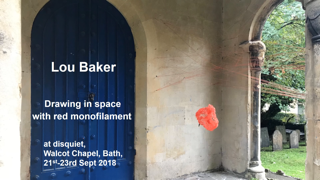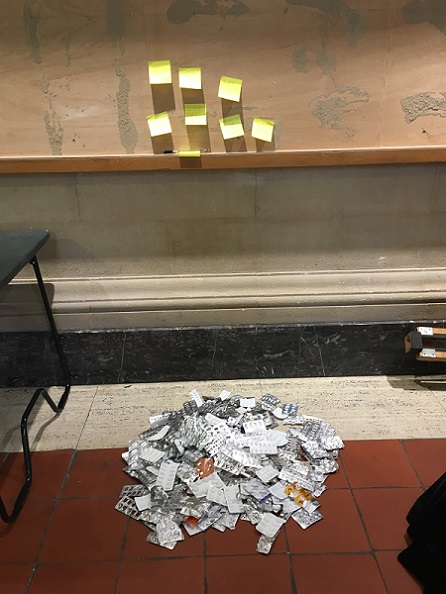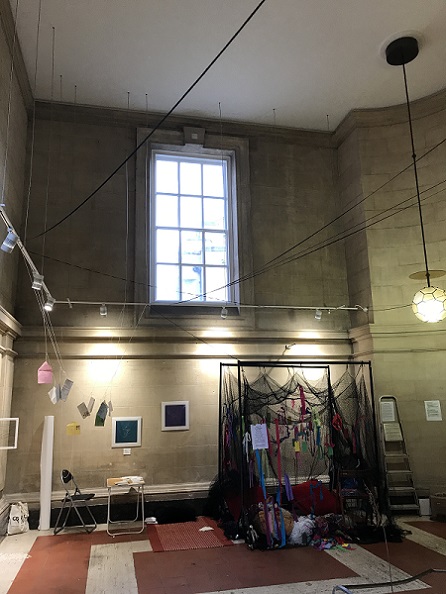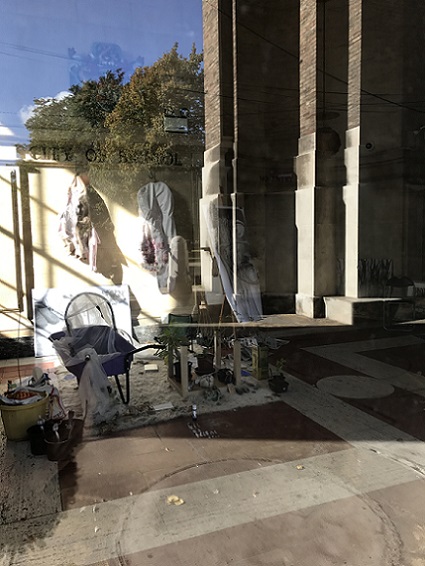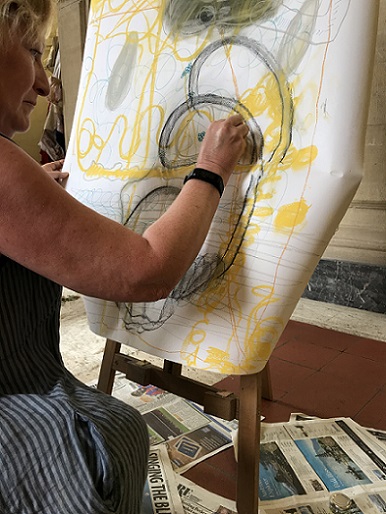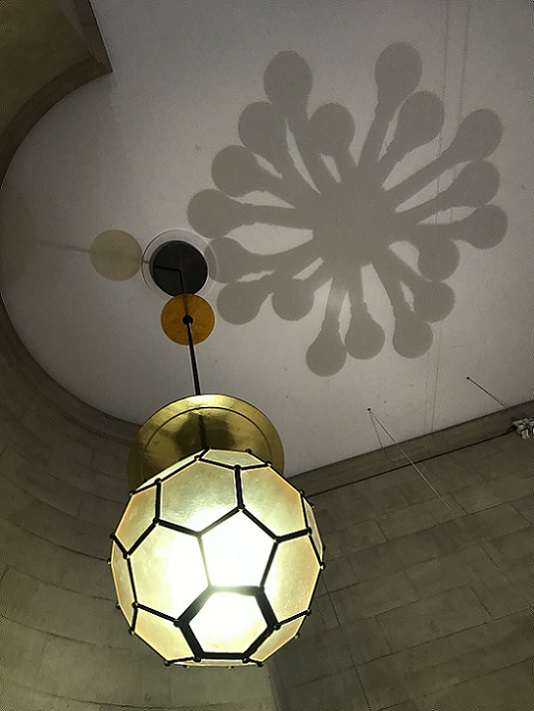*Please scroll down for more images and information about installations and site responsive works*
My installation and site responsive work
Many of my knitted and stitched sculptures are installed or hung. Most of them, especially the knitted pieces, rely on tension and/or gravity for their form. It is thrilling working with soft materials like cloth and knitted fabric as it’s so flexible, in every sense of the word.
As well as these soft sculptures, increasingly, over the past few years I've started making larger scale site responsive installations. So far I've used garden netting, string and monofilament and have ideas for plenty of other materials as well! Most of them are participatory too. Scroll down to find out more about these transformed spaces.....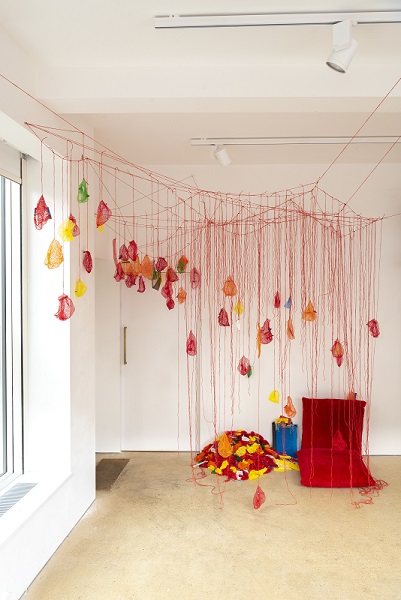
Tethering our thoughts at Incendiary, SVA, Stroud, Feb 2019
Shroud, 2013, installed at Unravelling, October 2016
That cloth is an unconventional medium in fine art also adds to the meaning it conveys. Traditionally, hard, durable materials like stone, marble and bronze have been used for sculpture; the soft, impermanent nature of cloth, however, evokes the human form and its mortality, revealing alternative meanings in its folds and surfaces (Barnett 1999: 186) and seems to ‘take on a bodily resonance rather than to offer up symbols as such’ (Nixon 2005: 174). 
All the babies I might have had I, felted hand knitting, 2010, installed in an empty shop at Pattern, Fringe Arts Bath, 2016. As I installed it I felt as if I was stitching it to the room!
Choosing to hang soft sculptures evokes an abject response and can be very powerful. An ‘empty’ hanging form suggests loss, absence and death. Hanging a sculpture also emphasises it’s ‘fragility and vulnerability’ (Larratt-Smith 2011). Louise Bourgeois asserts that the hanging thing ‘…is very helpless’ (in Nixon 2005:170) and ‘Hanging and floating are states of ambivalence and doubt’ (in Larratt- Smith 2011). It is clearly significant to her. I think the hanging motif distinguishes ‘very different identities for ... sculpture ... suggesting a kind of displacement’ (Barlow 1996: 9) which also adds to the feeling of abjection.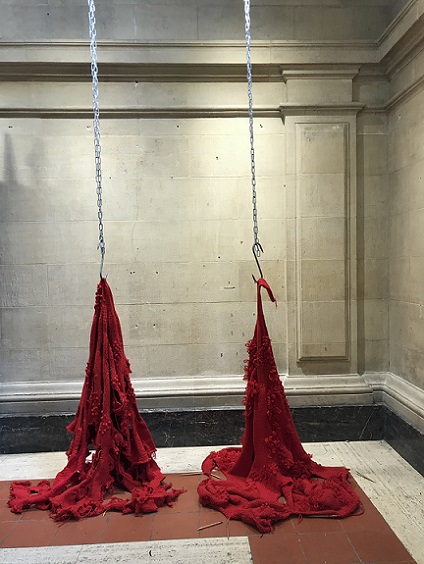
My Heart of darkness hand knitted diptych is especially versatile. Here are just 2 of the ways I've installed it. For more installations, see my Knitting page. Both of these were at [dis]place at The Vestibules, September 2017
Have a look at my Knitting and Stitch pages for more examples of how I have installed all my soft sculptures.
Many of my soft sculptures are also site responsive. I’m always particularly keen to install my work in unexpected places; it’s exciting to see how some pieces of work can have so many iterations. Have a look at the following exhibitions especially: Privy, Bodies at The Unit, Unravelling, Prilic, [dis]place, Window wanderland at 212 and several venues at Fringe Arts Bath in 2016 and 2017. Have a look at these pieces of work: Safety net, Shroud, Heart of darkness, All the babies I might have had I, Nobody 3.
And do have a look at my blog post Art in unexpected places? for more thoughts on this.
Nobody 3 installed at Unravelling, October 2016
Nobodies and The others are installations too!
Nobodies, 2014, installed at Synecdoche, Embassy Tea Gallery, London, July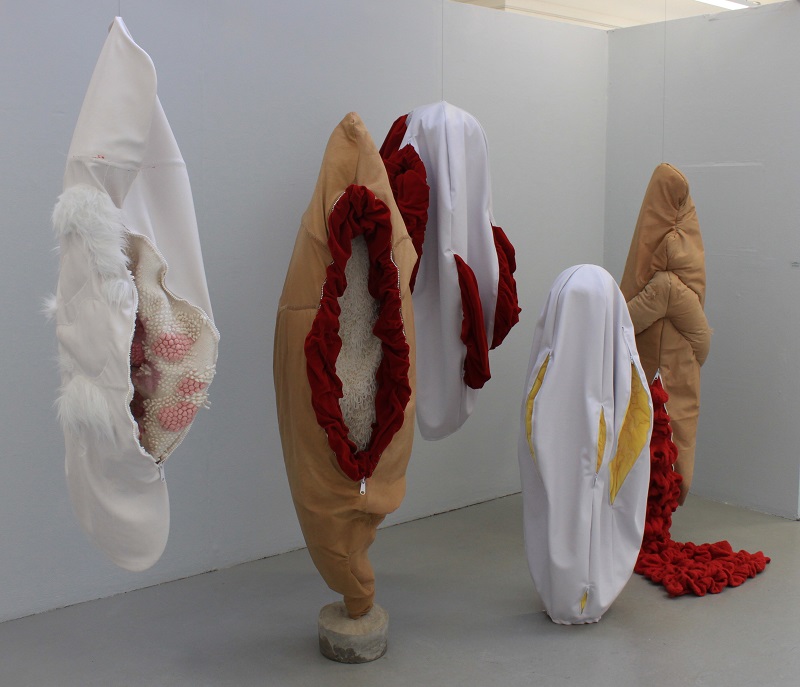
The others; a self portrait, installed at The Degree Show, UWE, Bower Ashton campus, Bristol, July 2015
I’m not really sure that all the parts of Displacement activity should be on this page either; Displacement activity #9: Sculpting with pill packets and a stapler could also be on the Stitch page, I think, and I’m not sure where Displacement activity #11: Collaborative drawing fits at all!
Nobody 3, 2014, hand knitted wool, meat hook, installed temporarily in the toilets at City Hall, during Synecdoche's [dis]place residency at The Vestibules, Bristol, September 2017
References:
Barlow, Phyllida, ‘The Sneeze of Louise’ in Cole, Ian, (ed.), 1996, Museum of Modern Art Papers, Volume 1 Louise Bourgeois, Oxford: Museum of Modern Art pp4-11
Barnett, Pennina, 1999, ‘Folds, fragments and surfaces: towards a poetics of cloth’ in Hemmings, Jessica (ed.), 2012, The Textile Reader, Berg: London, New York pp 182 -190
Larratt-Smith, Philip, 2011, Louise Bourgeois, the theory and practice of psychoanalysis, Available from: http://arttattler.com/archivebourgeois.html [Accessed 6 November 2013]
Nixon, Mignon, 2005, Fantastic Reality: Louise Bourgeois and a story of Modern Art, Cambridge, Massachusetts and London: MIT Press
2019 Red is the colour of.... at B-Wing, Shepton Mallet Prison, 21.9-6.10.2019
2019 IN.BRS.2019.39, Shadow sacks over dark pool, a collaboration with Scott Sandford at B-Wing, Shepton Mallet Prison 21.9-6.10.2019
2019 Shadow sacks (Slopping out room) at B-Wing, Shepton Mallet Prison, 21.9-6.10.2019
2019 The presence of absence, at B-Wing, Shepton Mallet Prison 21.9-6.10.2019
2019 Tethering our thoughts at Incendiary, SVA, Stroud, 6th -10th Feb

Tethering our thoughts is a site-responsive installation made with red string, with added fruit nets and labels! I loved making it. It was magical, like drawing in space or stitching the room! It was utterly absorbing. It’s my favourite kind of work; repetitive actions with plenty of intuitive decisions making it very meditative as well. I quickly entered that state of flow, where time flies. Bliss! 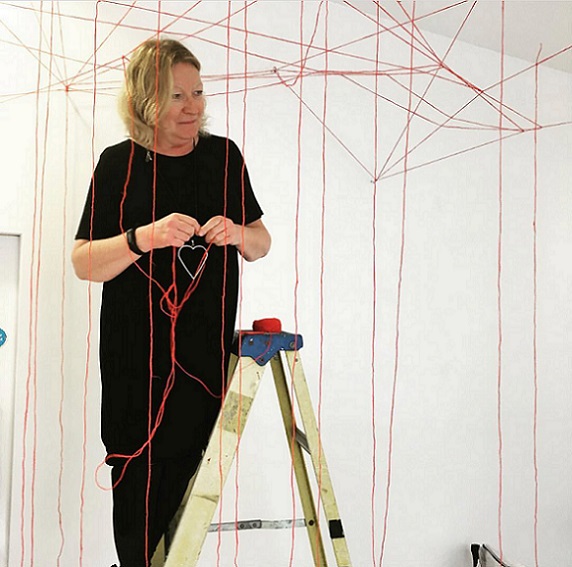
I especially enjoyed the unexpected ways that the string behaved. At times it looked as if the string were creating spontaneous drawings alongside my considered ones. The ends of string where I knotted the vertical strands created distinctive, self-supporting marks in space. I found it mesmerising. Next time I want to stitch a whole room!

Click on the image below to see my full documentation of Tethering our thoughts including the ideas behind the piece, set up, responses, my reflections and lots more images. This installation is also participatory, so there are more details on my Participatory art and social engagement page. 
2018 Unseen, drawing in space with red monofilament at disquiet exhibition, Walcot Chapel, Bath, Sept 21st -23rd
Over 3 days during the disquiet exhibition at Walcot Chapel in Bath I made a site responsive installation outside the chapel in the porch using red monofilament. I loved making it. It was like drawing in space.
Have a look at a slideshow of images by clicking the image below:
Also, here's a video of my drawing in space at Walcot Chapel.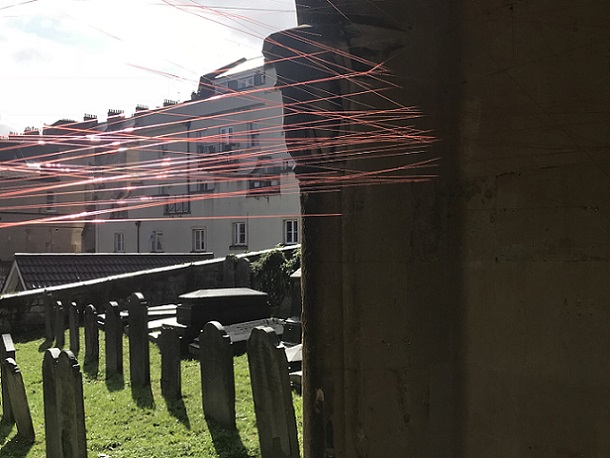
The chapel is a listed building so I couldn't make new holes which meant that I had to use the holes that were there, so there were limits to what I could do. I really enjoyed seeing what was possible within these parameters. I started by using any screws or nails that were already there, but I noticed that there were lots of holes with rawl plugs in them so on the second day I added some screw hooks. That gave me plenty more fixings and much more freedom!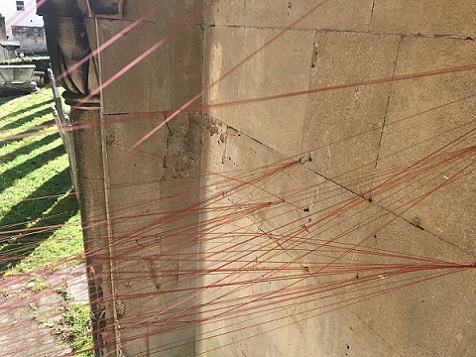
I really enjoyed the way that the monofilament changed with the light, and as it was installed. It’s obviously plastic, strong and weather resistant. Its normal function is fishing line. I like the idea of using something prosaic and manipulating it so that it becomes something unexpected. The installation was a transformation.
The form was basic; intersecting lines filling a space to one side of the chapel door, looking out over the graveyard. It interested me how the aesthetics changed as I added more to the piece. I noticed that the lines began to interfere with one another, some like an optical illusion and some physically, actually distorting the lines that had gone before. I felt it became something else, sparkling, web like, magical, yet almost invisible.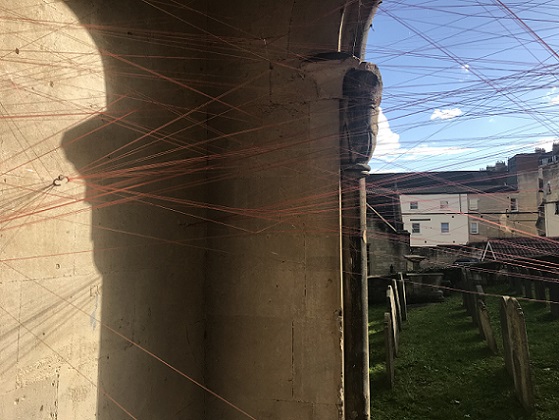
Although there was rarely anyone else present, it felt like a form of performance. It was blissful; I had to make intuitive decisions, it was repetitive and meditative. I quickly entered the state of flow where time flies.
One down side of its invisibility was that it was rather a hazard! Several people accidentally walked into it as they made to walk through the arch. Consequently, I added a sculptural piece of knitted monofilament, including knitting needles, to the installation to make it more visible. 
Knitting with monofilament is an uneasy change in control, as the unruly plastic line has a life of its own. Knitted monofilament looks rather like a magnificent scribble. Paradoxically, though, it needs a different, more intense kind of concentration, and more control than knitting with wool. I think adding this small knitted piece made an interesting contrast to the straight lines, and the seeming order, of the main part of the installation.
I’m intrigued by the ephemeral nature of an installation like this. I started making it on the 21st September and took it down on the 23rd. It was in situ just for 3 days, changing whenever I had time to work on it. It was seen by very few people, partly because of the setting, the weather and the fact that it was practically invisible! If I hadn’t documented it, no one else would have seen it, so, in some ways, the documentation becomes an extension of the art work. Now, thanks to the internet, potentially everyone could see it. It changes its reach and possibly its value. This extends to the performative aspects of its making as well; if nobody sees the performance and it’s not recorded, is it a performance? This all raises a number of questions for me and my practice. I know they’re not unique to me, but I want to investigate this transience further. 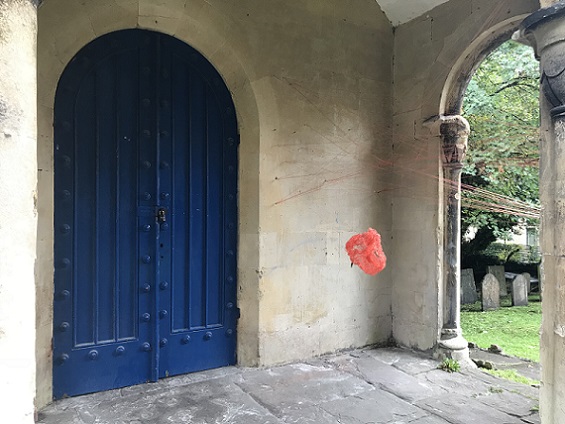
I'd like to do something similar in a much larger space, either outside or inside, and possibly both! It could be interesting to make an installation with monofilament amongst a copse of trees, or in an enclosed space. I’m currently looking for an opportunity to do both of these!
2017 Multitude at PRILIC exhibition, Jacobs Wells Baths, Bristol, December 8th-16th
Multitude is an installation of 11 of my life-sized stitched soft sculptures. Nine of them are suspended by meat hooks and chains from scaffolding 10 meters high, two of them are free standing. It’s the first time I have been able to install all of these sculptures together and it’s a dream come true!
Multitude is made up of a couple of series of sculptures (Nobodies and The others; a self-portrait) a knitted diptych (Heart of darkness) and a single sculpture (All the babies I might have had II). They have been exhibited in various combinations over the past couple of years and in a number of settings and have received a wonderful range of responses – attraction, repulsion, horror and hilarity amongst other things. I have documented a range of responses to them here.
Since I made the second series, The others, my vision has been to have a roomful of soft sculptures hanging close to one another so that walking through them becomes an immersive experience. Multitude is the closest I’ve come to this vision and it fills me with delight.
Jacobs Wells Baths was originally a Victorian swimming pool but has been a dance centre for the past 30 years and for the last couple of years it’s been a Community Arts centre. Several distinctive architectural features still reveal this astonishing building’s history; the tiled edge of the pool is still clearly visible, as are the remains of the rather primitive shower cubicles. The roof is arched with Victorian sky lights. The pool has been covered with a sprung wooden dance floor and at the far end of the cavernous space is a large dance mirror. Its semi derelict, dilapidated state is the perfect setting for my work.
I have been interested in the idea of art in unexpected places for a while and have shown my work in a number of unusual settings over the past few years – The Edwardian Toilets, The Vestibules, at several venues as part of Fringe Arts Bath in 2016 and 2017, at Unravelling, at Bodies in The Arcade and in the window of Room 212. I feel that my work becomes something ‘other’ in a non-traditional environment and that showing work in unusual spaces adds meaning to it.
Being involved in PRILIC has been an unexpected and thrilling ending to a busy year of exhibiting. I had visited the baths a couple of times since September oddly enough; once for Open Doors Day and once to attend an immersive theatre performance. Both times I’d thought it would be the perfect place to hang my work so when I saw a possible opportunity to exhibit there, I couldn’t resist. Much of my work makes public things that are normally private, so the theme was also perfect. PRILIC marks the end of an era, as a public building is about to be taken over by a corporate, private leisure company.
I saw the callout the week before the show was due to start so there wasn’t much time to plan or to gather materials for hanging. It was a great relief to arrive on set up day and be ably supported by Karen Van Hoey Smith and Josh Ben Tovim, the organisers. Karen had the same vision that I had; the sculptures hanging from high scaffolding in front of the mirror, low down so people could walk through them. I hadn’t realised what a difference it could make setting up my installation with two experienced, thoughtful and skilled people helping. And fortunately there was a high scaffolding ladder! Maybe this is what it would be like to have technicians?
Hanging my multiple sculptures in front of the mirror was magical; 11 became 22, a true multitude. I have been researching ways to use mirrors with my work recently so having the chance to try it out at PRILIC was wonderful.
Ideally I would have liked to hang each sculpture from a long chain attached to the scaffolding but it would have been prohibitively expensive. Maybe next time? Instead we used the chains I already had alongside some steel wire hanging devices and it was very effective. The sculptures still moved randomly at times!
We set up the installation in daylight and I was delighted with it. However, at the opening party the following evening my work was transformed by the lighting. It was mesmerising. Directional light from footlights changed the sculptures into something dramatic and surreal and the soft light of tea lights added an atmospheric glow. It hadn’t ever occurred to me before to experiment with lighting around my work so this was a revelation and definitely something to explore further.
The highlight for me was the dance response to my work by Josh Ben Tovim and Roseanna Anderson of Impermanence Dance Theatre at the closing event. Watch the video here. It was very poignant. As the dancers moved through the installation they swung the sculptures so that they too became part of the dance. Finding ways to make my sculptures move has been a big part of my process of making; I tried animatronics but actually found that when they hang some of the sculptures move randomly and spontaneously anyway. To see them move in this much more intentional and dramatic way as part of a performance was enlightening and inspirational. I have always regarded them as bodies in space with potential for performance and have worn them, so seeing them come alive in this context was thrilling. It makes me excited at the thought of what might be possible by collaborating with other artists, dancers and musicians in the future.
Many thanks to all those involved in the setup of PRILIC. I feel honoured to have been involved, grateful for the connections I’ve made and the people I’ve met and delighted to have had the opportunity to experiment with my multitude in such a spectacular space. It has been truly inspirational and aspirational. Where next, I wonder?
Gallery of images of Multitude:
1-3, 34, 35. The dance studio at Jacobs Wells Baths
4-8. Preparing for setup
9. Setup
10-13. Multitude, daytime
14, 16. Labels for Multitude, blackboard paint and chalk
15, 17-20, 23, 24, 26-32. Multitude, night time
21. Detail of Nobody 1
22. Detail of All the babies I might have had II
25. Dance performance by Impermanence Dance Theatre, closing party, 15.12.17
33. ‘It’s all yours’, chalk on the wall in the dance studio at Jacobs Wells Baths after take down
Displacement activity at Synecdoche's [dis]place residency at The Vestibules, Bristol, September 2th -29th 2017
Displacement activity
Noun:
a human activity that seems inappropriate, considered to arise unconsciously when a conflict between antagonistic urges cannot be resolved.
I am a compulsive knitter. I had expected to spend any spare time during this residency knitting but unfortunately, probably as a direct result of this obsession, I have had tendonitis in my left wrist so has had to stop, for a while at least.
Knitting is like breathing to me. I normally have some knitting with me and I knit wherever I am - on buses, on the beach, in the park and in the pub. It has a meditative quality about it; it calms me and helps me focus. Also, as I generally knit large pieces, I need to knit whenever and wherever I can in order to get enough knitting done.
Without it, I am bereft.
So, for this residency I have been spending my time on what I'm calling my displacement activities:
- responding to the spaces by experimenting with a series of temporary installations and interventions
- writing down comments and conversations that I have had with visitors and my reflections on that feedback
- documenting the residency by photographing the ways that the spaces change with time
Click on the image below for a presentation of part of the documentation of the work I did during this time.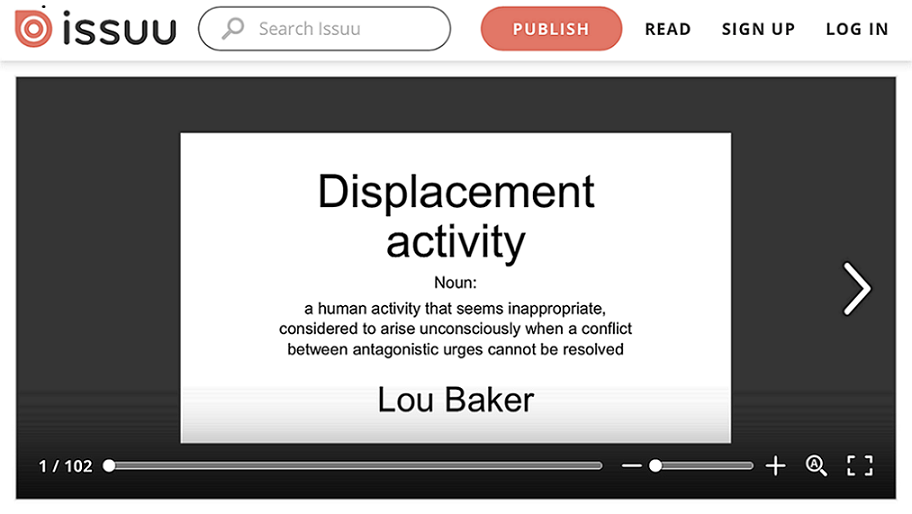
The displacement activities are:
Displacement activity #1: Pill packets and Post-its
Displacement activity #2: Mobile soft sculptures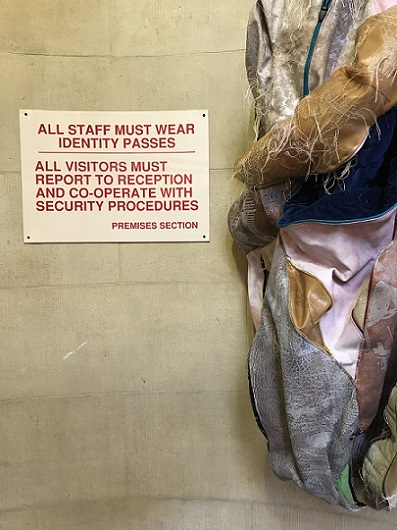
Displacement activity #3: Roaming sleeping bag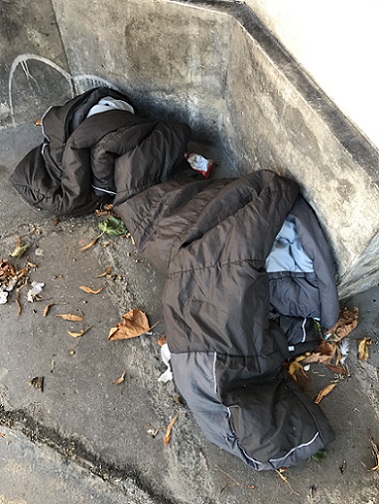
Click to watch a video of Displacement activity #4: Drawing in space with elastic …. (and a monkey)
Click to watch a video of Displacement activity #5: Helium balloons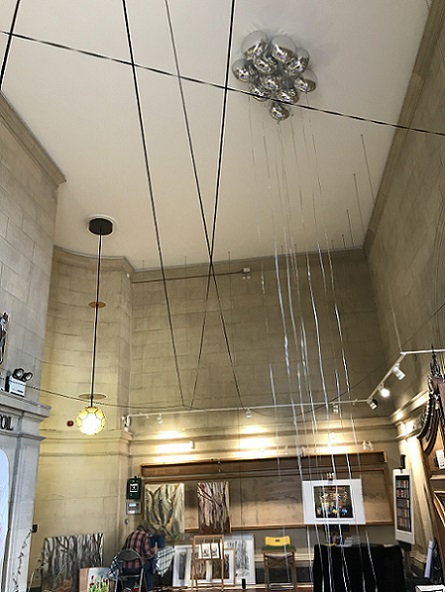
Displacement activity #6: Helium balloons and mirrors
Displacement activity #7: Look up, look down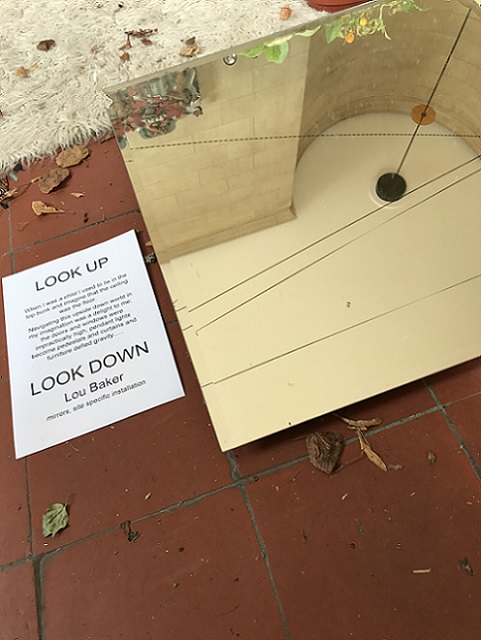
Displacement activity #8: Pill packets and hair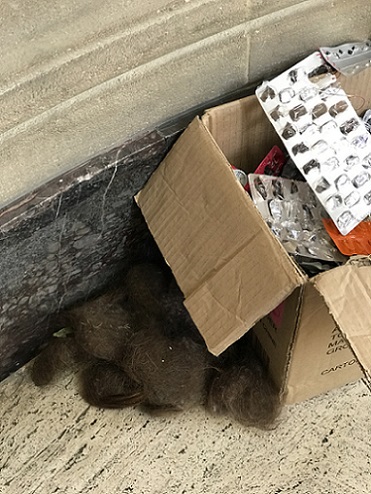
Displacement activity #9: Sculpting with pill packets and a stapler
Displacement activity #10: Shadows, light and reflections
Click to watch a video of Displacement activity #11: Collaborative drawing
Click to watch a video of Displacement activity #12: Projection 1
and click to watch a video of Displacement activity #12: Projection 2
Have a look at the documentation of Displacement activity here.
Read about Safety net at The Vestibules - I set it up and left it to do what it does for the 4 weeks of the residency. Here is a video showing how one participant responded.
#whatdoartistsdoallday #everydayisdifferent
@loubakerartist

